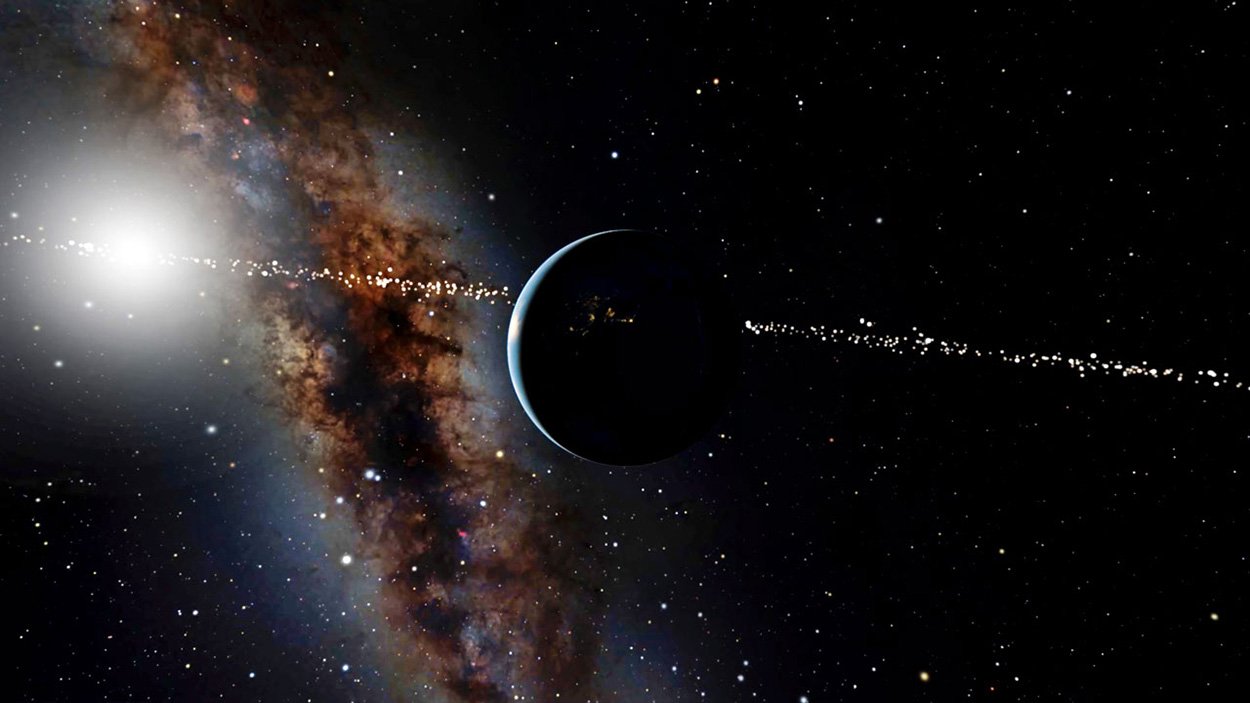Many exoplanets are betrayed by the fact that they pass directly in front of their Sun and thus darken for a short time. Two astronomers have now turned the tables and explored the stars through which the Earth’s transit can be seen through the Sun. Because this would be the most likely way extraterrestrial observers would discover our planet and its traces of life. The result: 1,402 stars currently have a clear view of transiting the Earth. 46 stars are so close to us that potential inhabitants of exoplanets can also pick up our radio waves, which have been radiating into space for about 100 years, in these systems.
Are we alone in the universe? Or is there life on other planets and perhaps extraterrestrial civilizations? We can still only speculate about it, because no traces of life or signals from inhabitants of alien worlds have yet been discovered. After all, astronomers have already discovered several thousand extrasolar planets and many of them orbit their star in the habitable zone. Most of these planets are found using the transit method: telescopes detect the slight dimming of the star caused by a planet passing in front of it. For nearby planets, scientists can also use highly sensitive spectroscopic instruments to determine the composition of their atmospheres. It leaves streaks in the star’s light spectrum that are specific to the elements and molecules. Astronomers hope to use this technology to soon find traces of life on these planets.
When the earth passes in front of the sun
Conversely, extraterrestrial astronomers can also use these methods to search for inhabited planets in their vicinity. “From an exoplanet perspective, we’re extraterrestrials,” explains Lisa Kaltenegger of Cornell University in Ithaca. Together with astrophysicist Jackie Ferti of the American Museum of Natural History, she investigated where to find our Earth using the transit method. “We wanted to know which stars have an appropriate viewpoint for observing the Earth because they block the sun,” Kaltenegger explains. In contrast to previous studies of this kind, the researchers also take into account when and for how long this “front row seat” is held for stars and other planetary systems. “As the stars move in our dynamic universe, they can move in the line of sight, but they can also leave it again,” says the astronomer.
For their study, the researchers evaluated the latest catalog from the European Gaia satellite, which determined the positions and motions of 1.8 billion celestial bodies in the Milky Way. “Gaia provides us with an accurate map of the Milky Way and allows us to go back and forth in time to see where the stars are and where they are heading,” Faherty explains. The assessment showed that a total of 2,034 stars would pass through the Earth’s transit zone between 5,000 years ago and 5,000 years from now – the region from which the Earth’s transit in front of the Sun can be seen. Of these, 313 objects have already been moved out of the region, and 319 will enter them in the future and 1,402 current stars with a clear view of Earth transit. Among these celestial bodies with free view are currently 128 Sun-like stars and 1,050 stars of the spectral category M – red dwarfs and red giants, as identified by astronomers.
Free viewing and reception of our radio waves
Of all these stars on “observation points,” those close enough to learn more about Earth in transit are of particular interest. As discovered by Kaltenegger and Fherty, there are currently 46 stars in the Earth’s transit zone and within a radius of 100 light-years. The researchers stated that “these 46 objects can monitor the passage of the Earth in front of the Sun and at the same time will be able to pick up radio waves from the Earth.” Because the radio messages and broadcasts that marked the beginning of the communications era about 100 years ago have since spread to about 100 light-years away. Based on estimates of planetary abundance around different types of stars, this could mean that about 29 potentially life-friendly planets are currently in the right position to detect both Earth and human radio waves, according to astronomers.
To date, only seven systems are known with planets of 2034 stars that will pass the transit zone of the Earth in the entire 10,000 year period. The closest to us is the red dwarf Ross 128, only 11 light-years away, with an Earth-like exoplanet. Its inhabitants – if they existed – could have seen the transit of the Earth for 2,158 years – from the time 3,057 years ago to about 900 years ago. However, the two planets around the star Teegarden, twelve light-years away, will appear in line of sight in 29 years. On the other hand, it takes a little longer for the TRAPPIST-1 system with the seven exoplanets, which is 40 light-years away, to get a clear view of Earth transit: they will enter the Earth’s transit zone in 1642 years, but then they remain in the “first row” for 2371 years.
“Our analyzes show that even nearby stars remain in a position to see Earth transits for more than 1,000 years,” Kaltenegger says. “This means that potential civilizations on the planets of these systems have enough time to discover Earth as an interesting planet.” However, whether these civilizations existed and whether extraterrestrial astronomers actually pointed their telescopes at Earth is unknown.
Source: Lisa Kaltenegger (Cornell University, Ithaca) et al., Nature, doi: 10.1038/s41586-021-03596-y

“Alcohol buff. Troublemaker. Introvert. Student. Social media lover. Web ninja. Bacon fan. Reader.”






More Stories
“Time seems to cure long Covid.”
Science: The use of artificial intelligence is changing the way hospitals operate
Simple recipe: sweet cream cheese slices from the tray